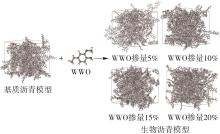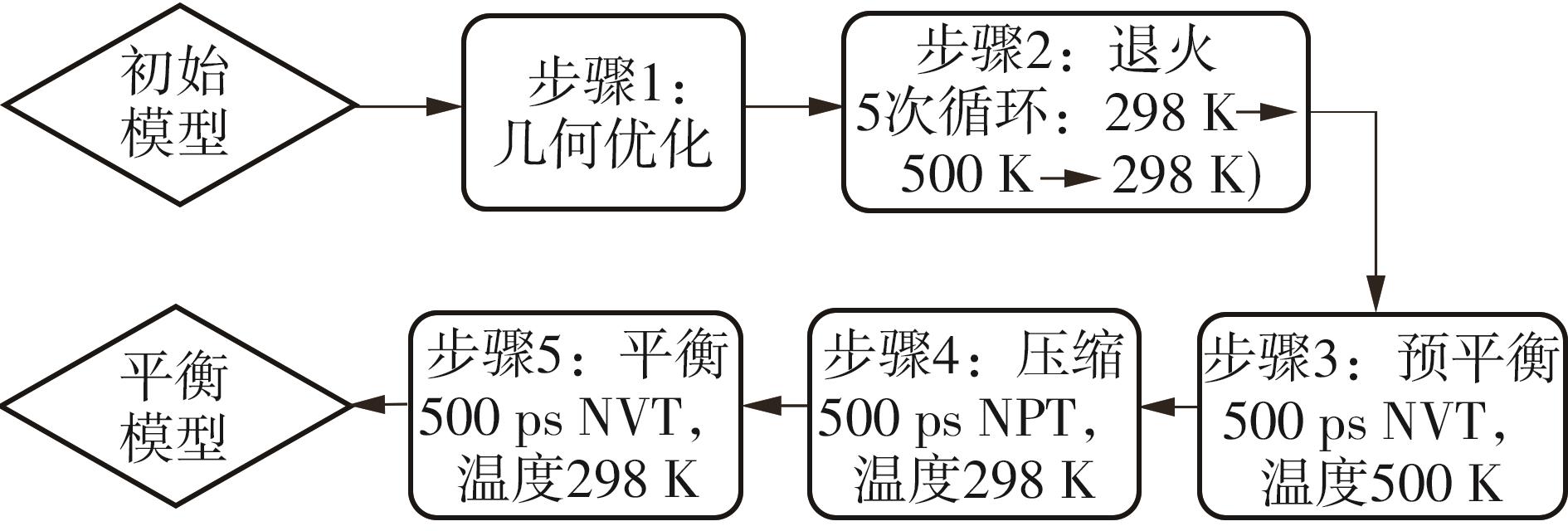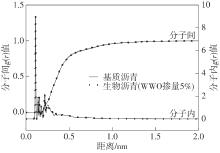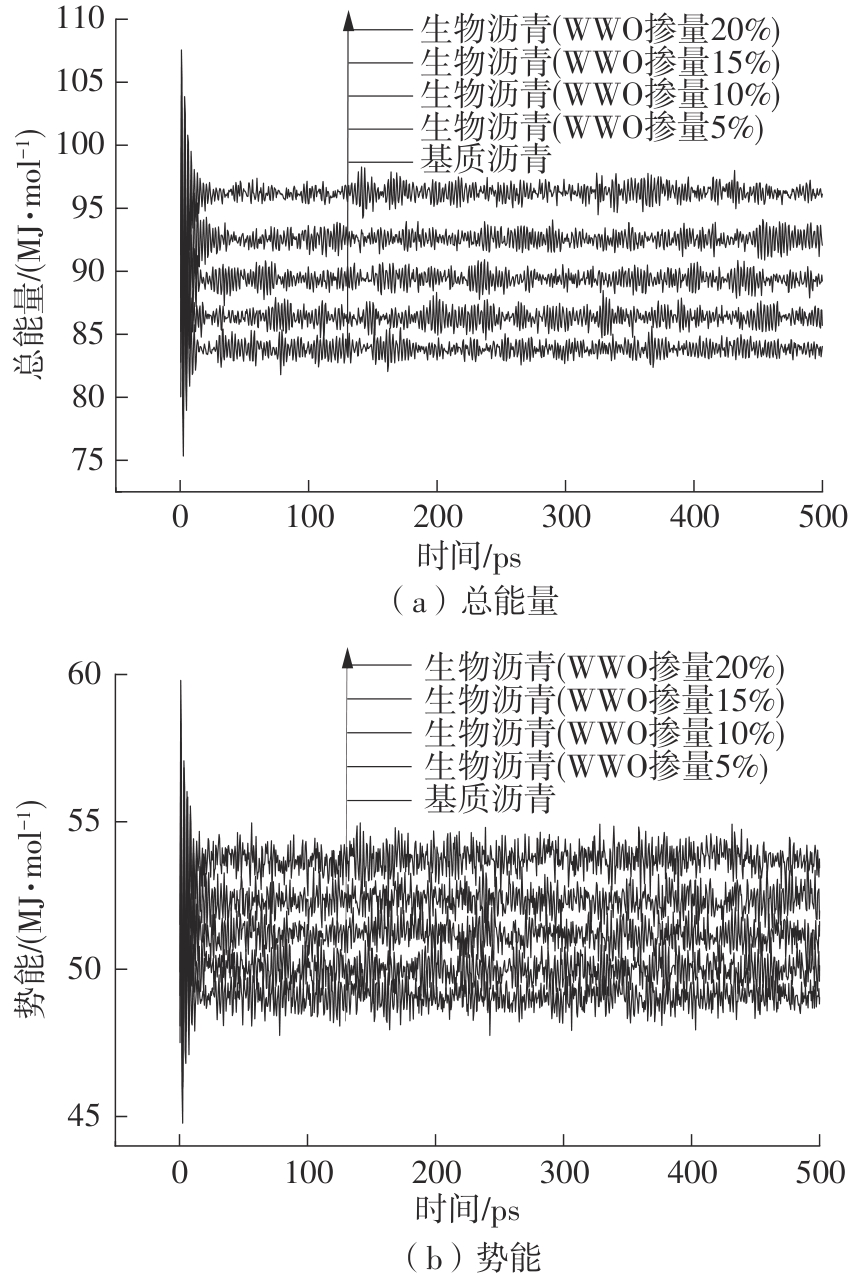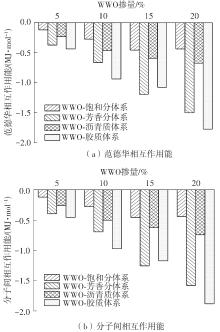Journal of South China University of Technology(Natural Science Edition) ›› 2024, Vol. 52 ›› Issue (12): 79-86.doi: 10.12141/j.issn.1000-565X.240112
Special Issue: 2024年力学
• Mechanics • Previous Articles Next Articles
Molecular Simulation of Interaction Behavior Between Asphalt Components and Waste Wood Oil
ZHENG Zhi1( ), GUO Naisheng1(
), GUO Naisheng1( ), YOU Zhanping2
), YOU Zhanping2
- 1.College of Transportation Engineering,Dalian Maritime University,Dalian 116026,Liaoning,China
2.Department of Civil and Environmental Engineering,Michigan Technological University,Houghton MI499 31,Michigan,USA
-
Received:2024-03-11Online:2024-12-25Published:2024-06-14 -
Contact:GUO Naisheng E-mail:zhizheng@dlmu.edu.cn;naishengguo@126.com -
Supported by:the National Natural Science Foundation of China(51308084)
CLC Number:
Cite this article
ZHENG Zhi, GUO Naisheng, YOU Zhanping. Molecular Simulation of Interaction Behavior Between Asphalt Components and Waste Wood Oil[J]. Journal of South China University of Technology(Natural Science Edition), 2024, 52(12): 79-86.
share this article
Table 2
Potential energies of different systems in bio-asphalt with a WWO dosage of 5%"
| 势能类别 | 组分 | 不同体系的势能/(kJ·mol-1) | ||
|---|---|---|---|---|
| WWO-组分 | WWO | 组分 | ||
| 范德华势能 | 饱和分 | 802.712 | 308.133 | 613.947 |
| 芳香分 | 988.501 | 308.133 | 1 052.867 | |
| 沥青质 | 1 107.773 | 308.133 | 1 032.130 | |
| 胶质 | 743.893 | 308.133 | 872.633 | |
| 静电势能 | 饱和分 | -981.435 | -282.323 | -698.731 |
| 芳香分 | -1 207.500 | -282.323 | -903.281 | |
| 沥青质 | -876.199 | -282.323 | -568.233 | |
| 胶质 | -1 735.080 | -282.323 | -1 431.760 | |
Table 3
Potential energies of different systems in bio-asphalt with a WWO dosage of 10%"
| 势能类别 | 组分 | 不同体系的势能/(kJ·mol-1) | ||
|---|---|---|---|---|
| WWO-组分 | WWO | 组分 | ||
| 范德华势能 | 饱和分 | 911.134 | 548.296 | 637.040 |
| 芳香分 | 764.370 | 548.296 | 879.573 | |
| 沥青质 | 1 070.606 | 548.296 | 989.167 | |
| 胶质 | 383.051 | 548.296 | 772.398 | |
| 静电势能 | 饱和分 | -1 362.370 | -662.725 | -697.451 |
| 芳香分 | -1 594.460 | -662.725 | -901.712 | |
| 沥青质 | -1 278.740 | -662.725 | -580.992 | |
| 胶质 | -2 133.490 | -662.725 | -1 435.830 | |
Table 4
Potential energies of different systems in bio-asphalt with a WWO dosage of 15%"
| 势能类别 | 组分 | 不同体系的势能/(kJ∙mol-1) | ||
|---|---|---|---|---|
| WWO-组分 | WWO | 组分 | ||
| 范德华势能 | 饱和分 | 1 060.916 | 854.910 | 662.968 |
| 芳香分 | 531.030 | 854.910 | 870.736 | |
| 沥青质 | 1 274.189 | 854.910 | 1 012.323 | |
| 胶质 | 751.352 | 854.910 | 973.608 | |
| 静电势能 | 饱和分 | -1 751.920 | -1 054.980 | -696.751 |
| 芳香分 | -1 998.270 | -1 054.980 | -882.193 | |
| 沥青质 | -1 666.290 | -1 054.980 | -580.217 | |
| 胶质 | -2 575.300 | -1 054.980 | -1 425.540 | |
Table 5
Potential energies of different systems in bio-asphalt with a WWO dosage of 20%"
| 势能类别 | 组分 | 不同体系的势能/(kJ∙mol-1) | ||
|---|---|---|---|---|
| WWO-组分 | WWO | 组分 | ||
| 范德华势能 | 饱和分 | 1 176.542 | 977.735 | 636.793 |
| 芳香分 | 518.999 | 977.735 | 1 043.160 | |
| 沥青质 | 1 267.697 | 977.735 | 964.738 | |
| 胶质 | 156.764 | 977.735 | 954.428 | |
| 静电势能 | 饱和分 | -2 231.260 | -1 535.300 | -694.366 |
| 芳香分 | -2 503.680 | -1 535.300 | -890.678 | |
| 沥青质 | -2 169.340 | -1 535.300 | -567.530 | |
| 胶质 | -3 082.670 | -1 535.300 | -1 440.620 | |
Table 6
Total intermolecular potential energies of different systems in bio-asphalts"
| WWO掺量/% | 组分 | 不同体系的分子间总势能/(kJ∙mol-1) | ||
|---|---|---|---|---|
| WWO-组分 | WWO | 组分 | ||
| 5 | 饱和分 | -178.723 | 25.810 | -84.784 |
| 芳香分 | -218.995 | 25.810 | 149.586 | |
| 沥青质 | 231.574 | 25.810 | 463.897 | |
| 胶质 | -991.188 | 25.810 | -559.125 | |
| 10 | 饱和分 | -451.239 | -114.429 | -60.410 |
| 芳香分 | -830.092 | -114.429 | -22.139 | |
| 沥青质 | -208.137 | -114.429 | 408.175 | |
| 胶质 | -1 750.440 | -114.429 | -663.428 | |
| 15 | 饱和分 | -691.000 | -200.075 | -33.784 |
| 芳香分 | -1 467.250 | -200.075 | -11.457 | |
| 沥青质 | -392.101 | -200.075 | 432.105 | |
| 胶质 | -1 823.950 | -200.075 | -451.929 | |
| 20 | 饱和分 | -1 054.720 | -557.564 | -57.572 |
| 芳香分 | -1 984.680 | -557.564 | 152.482 | |
| 沥青质 | -901.645 | -557.564 | 397.208 | |
| 胶质 | -2 925.910 | -557.564 | -486.195 | |
| 1 | BARZEGARI S, SOLAIMANIAN M .Rheological behavior of bio-asphalts and effect of rejuvenators[J].Construction and Building Materials,2020,251:118137/1-9. |
| 2 | GIRIMATH S, SINGH D .Effects of bio-oil on performance characteristics of base and recycled asphalt pavement binders[J].Construction and Building Materials,2019,227:116684/1-13. |
| 3 | GUO F, ZHANG J, PEI J,et al .Investigating the interaction behavior between asphalt binder and rubber in rubber asphalt by molecular dynamics simulation[J].Construction and Building Materials,2020,252:118956/1-10. |
| 4 | LV S, LIU J, PENG X,et al .Laboratory experiments of various bio-asphalt on rheological and microscopic properties[J].Journal of Cleaner Production,2021,320:128770/1-13. |
| 5 | DONG Z, ZHOU T, LUAN H,et al .Composite modification mechanism of blended bio-asphalt combining styrene-butadiene-styrene with crumb rubber:a sustainable and environmental-friendly solution for wastes[J].Journal of Cleaner Production,2019,214:593-605. |
| 6 | LIN H, CHEN Q, LUO X,et al .Characterization of rheological properties and aging performance of bitumen modified by bio-oil from bamboo charcoal production[J].Journal of Cleaner Production,2022,338:130678/1-12. |
| 7 | XU J, GUO Z, LU G,et al .Reclamation of waste oils in asphalt modification towards enhanced low-temperature performance of pavement in cold region[J].International Journal of Pavement Engineering,2022,24(2):2069244. |
| 8 | HUANG T, HE H, ZHANG P,et al .Laboratory investigation on performance and mechanism of polyphosphoric acid modified bio-asphalt[J].Journal of Cleaner Production,2022,333:130104/1-16. |
| 9 | ZHENG W, WANG H, YOU Z,et al .Mechanism and rheological characterization of MDI modified wood-based bio-oil asphalt[J].Construction and Building Materials,2021,309:125113/1-11. |
| 10 | LYU L, MIKHAILENKO P, PIAO Z,et al .Unraveling the modification mechanisms of waste bio-oils and crumb rubber on asphalt binder based on microscopy and chemo-rheology[J].Resources Conservation and Recycling,2022,185:106447/1-14. |
| 11 | WANG J, LI Q, LU Y,et al .Effect of waste-oil regenerant on diffusion and fusion behaviors of asphalt recycling using molecular dynamics simulation[J].Construction and Building Materials,2022,343:128043/1-17. |
| 12 | 徐宁,汪海年,陈玉,等 .基于分子动力学的生物沥青相容性研究[J].华南理工大学学报(自然科学版),2022,50(5):65-72. |
| XU Ning, WANG Hainian, CHEN Yu,et al .Research on the compatibility of bio-asphalt based on molecular dynamics[J].Journal of South China University of Technology (Natural Science Edition),2022,50(5):65-72. | |
| 13 | 屈鑫,丁鹤洋,王超,等 .基于分子动力学模拟技术的生物质油改性沥青微观性能研究[J].材料导报,2022,36(19):124-129. |
| QU Xin, DING Heyang, WANG Chao,et al .Research on micro properties of bio-oil modified asphalt based on molecular dynamics simulation technique[J].Materials Reports,2022,36(19):124-129. | |
| 14 | LI D D, GREENFIELD M L .Chemical compositions of improved model asphalt systems for molecular simulations[J].Fuel,2014,115:347-356. |
| 15 | ZHENG X, XU W, XU H,et al .Research on the ability of bio-rejuvenators to disaggregate oxidized asphaltene nanoclusters in aged asphalt[J].Acs Omega,2022,7(25):21736-21749. |
| 16 | ZHU X, DU Z, LING H,et al .Effect of filler on thermodynamic and mechanical behaviour of asphalt mastic:a MD simulation study[J].International Journal of Pavement Engineering,2020,21(10):1248-1262. |
| 17 | LI G, TAN Y, FU Y,et al .Density,zero shear viscosity and microstructure analysis of asphalt binder using molecular dynamics simulation[J].Construction and Building Materials,2022,345:128332/1-11. |
| 18 | LI C, FAN S, XU T .Method for evaluating compatibility between SBS modifier and asphalt matrix using molecular dynamics models[J].Journal of Materials in Civil Engineering,2021,33(8):04021207/1-13. |
| 19 | 郑直,郭乃胜,尤占平,等 .废木油与石油沥青相容机制的分子动力学研究[J].化工学报,2023,74(10):4037-4050. |
| ZHENG Zhi, GUO Naisheng, YOU Zhanping,et al .Research on compatibility mechanisms between waste wood oil and petroleum asphalt through molecular dynamics[J].Journal of Chemical Industry and Engineering,2023,74(10):4037-4050. | |
| 20 | LU P, HUANG S, SHEN Y,et al .Mechanical performance analysis of polyurethane-modified asphalt using molecular dynamics method[J].Polymer Engineering and Science,2021,61(9):2323-2338. |
| 21 | 曹雪娟,易柳,丁勇杰,等 .基于分子动力学模拟改性剂掺量对改性沥青微观作用影响研究[J].化工新型材料,2022,50(7):175-182. |
| CAO Xuejuan, YI Liu, DING Yongjie,et al .Study on the influence of micro action of modifier content on modified asphalt based on molecular dynamics simulation[J].New Chemical Materials,2022,50(7):175-182. | |
| 22 | LIU Q, HAN B, WANG S,et al .Evaluation and molecular interaction of asphalt modified by rubber particles and used engine oil[J].Construction and Building Materials,2022,375:134222/1-12. |
| [1] | ZHANG Chi, GUO Tingyu, HU Ruilai, et al. Research on Average Longitudinal Slope Index of Expressway Based on Braking Behavior [J]. Journal of South China University of Technology(Natural Science Edition), 2025, 53(2): 12-26. |
| [2] |
ZHANG Yandi, HUI Bing, MA Ziye, et al.
Quantitative method of aggregate spalling degree of Chip Seal in three Dimension [J]. Journal of South China University of Technology(Natural Science Edition), 2025, 53(2): 80-91. |
| [3] | WANG Wei, TAN Yiqiu, XU Yongjiang. Study on Internal Stress of Asphalt Mixture Under Three-Point Bending Mode [J]. Journal of South China University of Technology(Natural Science Edition), 2024, 52(10): 101-111. |
| [4] | LI Baijian, HUANG Yan, FU Xinsha. Influence of Shapes of Corrugated Steel Plate on Load-Carrying Capacity of Reinforced Concrete Slab Culvert and Arch Effect with Lateral Restraint [J]. Journal of South China University of Technology(Natural Science Edition), 2024, 52(1): 110-118. |
| [5] | MAO Xuesong, WANG Yueyue, WU Qian, et al. Structure Evolution Law of Soil-Rock Mixture Fillers with Different Gradations Under Seepage [J]. Journal of South China University of Technology(Natural Science Edition), 2023, 51(2): 65-75. |
| [6] | YU Bin, ZHANG Yuqin, WANG Yuchen, et al. Automated Extraction of Road Geometry Information Using Mobile LiDAR Point Cloud [J]. Journal of South China University of Technology(Natural Science Edition), 2023, 51(2): 88-99. |
| [7] | XU Ning, WANG Hainian, CHEN Yu, et al. Research on the Compatibility of Bio-Asphalt Based on Molecular Dynamics [J]. Journal of South China University of Technology(Natural Science Edition), 2022, 50(5): 65-72. |
| [8] | ZHANG Chi, REN Shipeng, WANG Bo, et al. Speed Characteristics and Prediction of Trucks on Long and Steep Downgrade Sections [J]. Journal of South China University of Technology(Natural Science Edition), 2022, 50(3): 38-49. |
| [9] | ZHAO Jin, QIN Yangjun, LIU Chang, et al. Research on Graphene-based Heat Transfer in Nanochannel by Using Non-equilibrium Molecular Dynamics [J]. Journal of South China University of Technology(Natural Science Edition), 2022, 50(3): 140-146. |
| [10] | FU Guozhi, WEI Jincheng, ZHAO Yanqing, et al. Influence of Asphalt Pavements' Dynamic Effects on the Surface Acceptance Deflection [J]. Journal of South China University of Technology (Natural Science Edition), 2021, 49(4): 90-96. |
| [11] | AI Changfa, HUANG Yangquan, LUO Liufen, et al. Estimation of Comprehensive Impact of External Factors on Interlayer Fatigue Life of Asphalt Pavement Based on ISS & SSDR [J]. Journal of South China University of Technology (Natural Science Edition), 2020, 48(5): 58-66,74. |
| [12] | ZHANG Chi, HU Tao, LIN Xuancai, et al. Research on Exclusive Low-Speed Lane for Large Truck in Highway Continuous Long Downhill Section [J]. Journal of South China University of Technology (Natural Science Edition), 2020, 48(4): 104-113. |
| [13] | LI Baijian ZHU Liangsheng FU Xinsha LI Yong . Mechanical Properties of Two Kinds of Lined Reinforced Concrete Pipe Culvert [J]. Journal of South China University of Technology(Natural Science Edition), 2019, 47(6): 101-107. |
| [14] | ZHU Jianghong HAN Shuxian TONG Yanmei LI Yan YU Rongguang ZHANG Huyuan. Effect of Dry-Wet Cycles on the Deterioration of Sandstone with Various Initial Dry Densities [J]. Journal of South China University of Technology (Natural Science Edition), 2019, 47(3): 126-134. |
| [15] | ZHANG Chi HOU Yudi QIN Jihan ZHANG Hong. Safety Design Method of Long Slope Downhill Slope Based on Temperature Increase of Brake Drum [J]. Journal of South China University of Technology(Natural Science Edition), 2019, 47(10): 139-150. |
| Viewed | ||||||
|
Full text |
|
|||||
|
Abstract |
|
|||||
